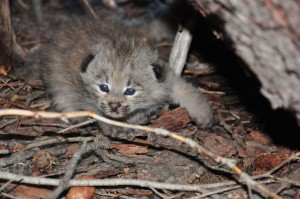
Lynx kitten photographed during the Division of Wildlife's annual spring surveys. Photo: Tanya Shenk, Colorado Division of Wildlife.
 After 11 years of returning lynx to Colorado, wildlife officials say a viable population is in place.
After 11 years of returning lynx to Colorado, wildlife officials say a viable population is in place.
Thirty-seven years after the last known lynx was trapped in Colorado, state wildlife officials are hailing an 11-year reintroduction program for establishing a viable population of lynx here again.
On Friday, officials declared the effort a success and announced they were switching from reintroducing the lynx to monitoring them as they spread throughout their adopted range.
“It’s taken a long time to get here,” said Colorado Division of Wildlife Director Tom Remington, who said his agency is now considering a similar program for the wolverine.
The program’s success was not always clear. The first reintroduced lynx struggled and in some years researchers were unable to document any new kittens. Scientists say the future is still somewhat uncertain for the threatened wildcat due to climate change, wildfires, bark beetle epidemics and future development that could change lynx habitat.
But scientists say the program has succeeded in establishing a breeding population of lynx in the Southern Rockies in which more lynx are being born than are dying, and first- and maybe second-generation lynxes are having kittens.
“It’s an example of what we can do when we have a vision and the will to see it through,” Gov. Bill Ritter said in a prepared statement.
Listed in 2000 as a threatened species under the Endangered Species Act, the lynx was once a wary resident of the Colorado high country, appearing here in lower numbers than in the northern Rockies, where its main meal, the snowshoe hare, are in greater numbers. The last known Colorado lynx was trapped near Vail in 1973.
In 1999, DOW officers launched the reintroduction program by releasing lynx captured in Alaska and Canada into the remote San Juan Mountains in southwest Colorado. From 1999 until 2006, the DOW introduced 218 lynx, monitoring cats fitted with radio and satellite collars as they settled in a core area and expanded into other parts of Colorado’s high country.
“There was some question as to whether the lynx could survive today,” Remington said. “With highways. With people. With collisions. With all the activity. The lynx is a wilderness animal.”
The first reintroduced lynx struggled, but wildlife officers discovered that by fattening them up for several weeks in captivity, their survival improved. The first kittens appeared in 2003, and their numbers grew for two years then sputtered. In 2007 and 2008, when snowshoe hares declined, scientists found no new lynx kittens. The news was mixed, though. Usually, Remington said, fewer snowshoe hares means the deaths of adult lynx, too, but that didn’t happen, raising hopes that the lynx would pull through.
Between 2003 and 2010, at least 141 lynx kittens were born, in some cases to first-generation and possibly second-generation Colorado lynx. Last spring, biologists found 14 kittens in five separate dens, including the first two dens documented in Summit County, outside the core reintroduction area. Because not all lynx have satellite collars, officials believe more kittens may have been born.
Officials believe more lynx are being born in Colorado than are dying, giving hope that the population will take hold.
“I think they’re going to be fine,” Remington said. “They’ll continue to increase in population as they colonize new habitat.”
Biologists plan to use techniques like trail cameras, snow tracking and genetic sampling to continue to track the lynx instead of capturing and collaring them. Biologists say the new approach will give less information about individual cats but more about how the population is behaving throughout the state and will avoid the stress of capture.
“We’ve done everything necessary to restore lynx to Colorado,” said Rick Kahn, the retired Division of Wildlife official who led the reintroduction program for more than a decade. “Now it’s up to the cats to continue to respond as they have for the past 10 years.”

